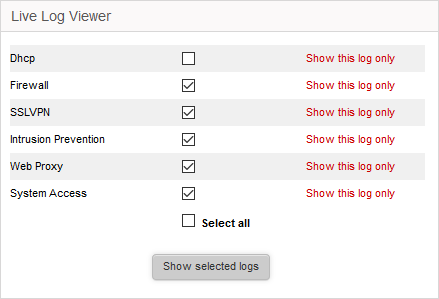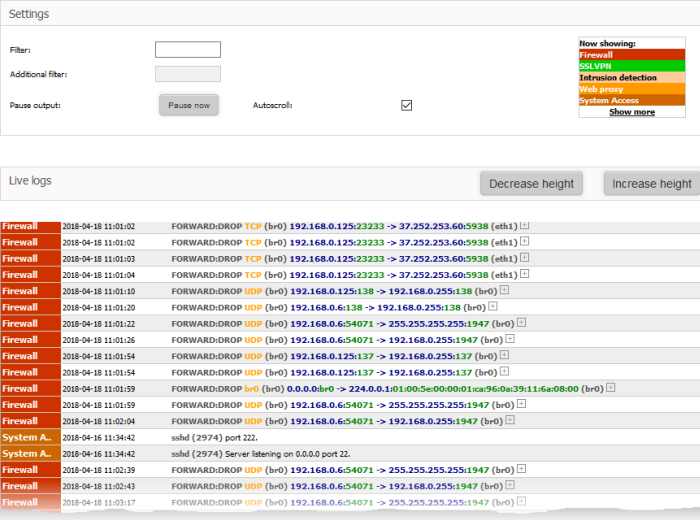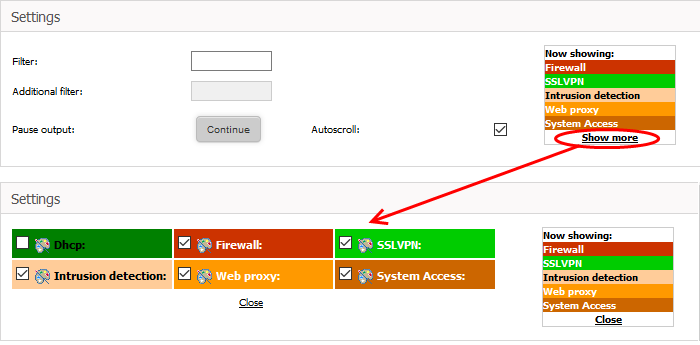Realtime Logs
- Click 'Logs' on the left then choose 'Live'
- Select the logs you wish to view:

- Click 'Show selected logs' to open the live logs interface.
- This is a rolling, continuously updated list of events happening on your network:

Logs are color coded so you can easily see which module they relate to.
Logs are available for the following modules:
- DHCP - Events from the DHCP server module of Dome Firewall. This includes assignment of fixed and dynamic IP addresses to devices in different internal network zones.
- Firewall - Log of connection attempts that were allowed or blocked by the firewall. Click the '+' button at the right of a log entry to view the source and destination addresses, the connection protocol and more.
- SSLVPN - Events relevant to SSL VPN connections.
- Intrusion detection - Events generated by the intrusion detection system (IDS) service.
- Web proxy - Events generated by the HTTP/HTTPS proxy services.
- System Access - Record of user logins to the firewall.
- Type a string in the filter box to view logs which contain specific text. This can be anything you see in the log itself. For example, a date, action, protocol, ip address or port.
- Click 'Show More' in the 'Now Viewing' box to add or remove modules from the live list.
Click
the '+' button at the right of any 'Firewall' log entry to view its
details.
Settings
The Settings area contains the options and controls for the following:
The modules currently included in the stream are listed at the top right. Each module name is color-coded.
To add or remove modules to view the logs
-
Click the 'Show More' link at the top right. A list of modules will be displayed.

-
Select the modules for which you wish to view the live logs and deselect the modules for which you do not wish to view the live logs
The realtime log entries corresponding only to the selected modules are displayed in the lower pane.
- Enter a keyword for the primary filter in the 'Filter' text field
- Optional. Fine-tune the filter by entering a second keyword in the 'Additional filter' field
The logs shown in the lower pane will automatically update according to your filter.
- By default, the Live Log viewer is dynamically updated with the current events that are pertinent to the selected modules.
- Admins may want to temporarily stop the updates to analyze existing events.
- Click the 'Pause now' button to temporarily halt the stream..
- Click 'Continue' to resume updates.
The dynamically updated live log viewer can automatically scroll upwards to show the chronologically added latest entries at the bottom of the list. If the autoscrolling is not enabled, the administrator can use the scroll bar at the right to move the list upwards to see the latest entries.
- To enable autoscrolling, select the 'Autoscroll' checkbox
|
Note: The 'Autoscroll' will be available only if the live log viewer is configured to sort the entries in chronological order, that is the latest entries added to the bottom of the list. If the live log viewer is configured to sort the entries in reverse chronological order by selecting the option 'Sort in reverse chronological order' from the Settings interface, the 'Autoscroll' option will not be available. See 'Configure Log Settings' for more details on configuring the log viewer. |
Change height of the Log Viewer
The Live Logs area displays the
list of events pertaining to the selected modules and services. Each
entry contains the log type, the precise date and time of the event
and the message describing the event. You can
increase or decrease the height of the live log viewer.
- To increase the height of the log viewer in order to view large number of log entries at once, click 'Increase height' repeatedly. The height is increased by two entries for a single click
- To
reduce the height of the log viewer, click 'Decrease height'. The
height is decreased by two entries for a single click



